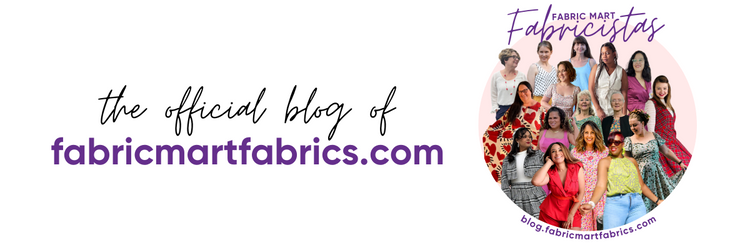Hello Sewing Friends! Sharon here with my latest Fabricista make, a lightweight kimono influenced topper – or is it?
The fabric I used is a polyester bubble crepe, lightweight and airy, perfect for my loose-fitting topper. If you’ve heard that lightweight polyester fabrics are difficult to sew, don’t be afraid to try this bubble crepe. I was pleasantly surprised that it was fairly easy to handle and sew.
Even though polyester fabric does not shrink, I prewashed the fabric. I prefer to make sure any potential sizing has been removed from my fabrics before I sew my garments.
I placed an old cardboard cutting board on top of my cutting table and cut out my pattern pieces with the fabric on top of the board. It helped keep everything from slipping while I pinned and cut. Pattern weights would have worked well also.
Because the fabric is lightweight and translucent (meaning light does pass through so it’s semi-transparent) a French seam would make for a beautiful inside finish. However, I finished all the seams with a narrow three-thread on my serger using black thread which blended in very well.
Interfacing was required along the front band. I used Palmer/Pletch Perfect Fuse Sheer which provided the body needed without being too stiff.
The feature I love best about this is the sleeves, which are two large flounces and look like butterfly sleeves. They move so beautifully!
Some patience is needed as those flounces are finished with a tiny hem. I serged a three-thread stitch on the edge of the sleeves then turned under and stitched in place.
I have a secret to share with you. I’m really pleased with my kimono influenced topper, but the pattern I used is actually a robe pattern, the Designer Stitch Marieke Robe.
That means this is a double duty garment – perfect for when we travel. I have a robe to toss on in the hotel room, a topper to wear to dinner with jeans or over my swimsuit while lounging at the pool.
I also sewed a pair of calf-length ruffled pajama bottoms, using Simplicity 8995 (which is now out-of-print). They're cute enough to double as a faux skirt!
When I am trying to decide what I want to sew, I look at the line drawings rather than rely on the name (in this case robe) or the modeled photos. While the fabric is recommended for the robe pattern, it was not a recommended fabric for the pajama bottoms. Yet it worked beautifully! Give yourself permission to think outside the box and experiment.
Because of the versatility, these two pieces will go into my luggage on our next trip.
Lastly, you know I wouldn’t make it through an entire photo shoot without my big dog making her way into at least one picture!
Until next time, Happy Sewing!
SHARON | @thesharonsews
Unfortunately Fabric Mart Fabrics sell out quickly!
You can find similar fabrics by shopping the following categories CREPE.










You prove how beautiful poly chiffon can be, when paired with an appropriate pattern. Your new pieces are beautiful, and your proposed use is perfect.
ReplyDeleteIts beautiful!
ReplyDeleteSharon, gorgeous, great ideas and wonderfully made. Thanks for sharing! Missed you too.
ReplyDelete